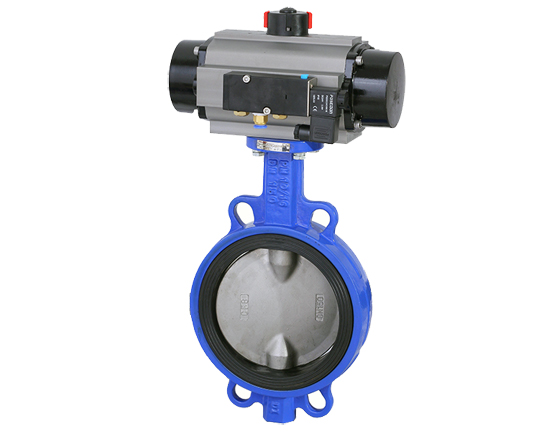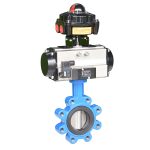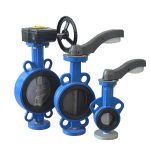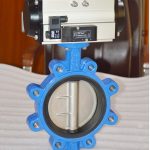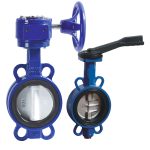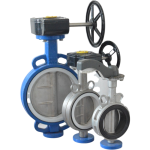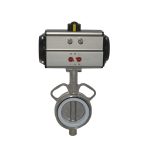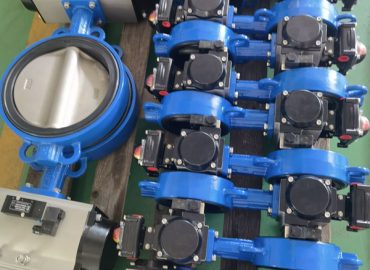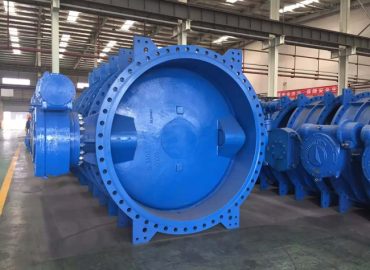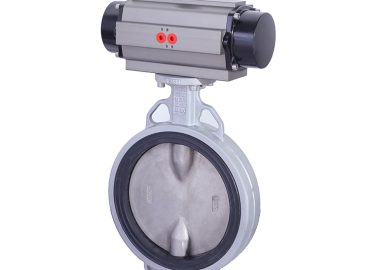Butterfly valves play a crucial role in controlling the flow of fluids and gases in various industries, making it essential to understand their standard dimensions for proper installation and seamless operation. Among the different sizes available, the 10-inch butterfly valve is commonly used due to its versatility and wide range of applications. In this article, we will delve into the standard dimensions of a 10-inch butterfly valve, discussing its key components and factors that influence its size. By understanding these dimensions, you can ensure optimal performance, extend the lifespan of the valve, and maintain the safety of your equipment and operations.
Introduction
The standard dimensions of a 10-inch butterfly valve are crucial for ensuring proper compatibility with piping systems, maintaining optimal performance, and safeguarding equipment and operations from potential hazards. A 10-inch butterfly valve typically refers to the size of the pipe it is designed to fit, with the actual dimensions of the valve components varying based on factors such as material, pressure rating, and seat material. Key dimensions to consider include the face-to-face (F2F) dimension, which is the distance between the inlet and outlet flanges of the valve, the flange-to-flange (F2F) dimension, which is the distance between the centers of the connecting flanges, the disc diameter, stem diameter, and actuator dimensions (if applicable). Additionally, the bolt circle diameter (BCD) and the number of bolt holes are important to ensure proper alignment and secure connections between the valve and the piping system. It is important to note that these dimensions may vary slightly depending on the manufacturer and valve design; hence, consulting manufacturer specifications and guidelines is essential for choosing the right valve for your application. By understanding and adhering to the standard dimensions of a 10-inch butterfly valve, you can facilitate smooth installation, enhance the valve’s longevity, and maintain a safe and efficient operation in your industry.

| SIZE | A | B | C | D | E | F | d | G | H | L | WT(kg) | |
| DN | INCH | |||||||||||
| 50 | 2″ | 126 | 78 | 13.5 | 94.3 | 9 | 50 | 8 | 70 | 31 | 43 | 2 |
| 65 | 2 1/2″ | 134 | 84 | 13.5 | 107.6 | 9 | 50 | 8 | 70 | 45 | 46 | 2.5 |
| 80 | 3″ | 138 | 92 | 13.5 | 123.9 | 9 | 50 | 8 | 70 | 64 | 46 | 3 |
| 100 | 4″ | 167 | 114 | 13.5 | 157 | 11 | 70 | 10 | 90 | 91 | 52 | 4.5 |
| 125 | 5″ | 180 | 129 | 17.5 | 181.5 | 14 | 70 | 10 | 90 | 110 | 56 | 6 |
| 150 | 6″ | 203 | 144 | 17.5 | 212 | 14 | 70 | 10 | 90 | 146 | 56 | 7 |
| 200 | 8″ | 228 | 179 | 24.5 | 267.4 | 17 | 102 | 12 | 125 | 193 | 60 | 12 |
| 250 | 10″ | 266 | 216 | 25 | 323.6 | 22 | 102 | 12 | 125 | 241 | 68 | 17 |
Briefly introduce butterfly valves and their applications
Butterfly valve are a type of flow control device widely used in various industries to regulate and isolate the flow of fluids and gases through a piping system. These valves consist of a rotating disc mounted on a stem, which can be turned to open, close, or partially obstruct the flow path. Butterfly valves are known for their compact design, lightweight nature, and cost-effectiveness, making them a popular choice for numerous applications. They are commonly employed in water and wastewater treatment, chemical processing, food and beverage production, HVAC systems, and power generation, among other industries. By providing precise control over fluid flow with minimal pressure loss and quick actuation capabilities, butterfly valves play an essential role in ensuring efficient and reliable operations across a multitude of industrial applications.

Importance of knowing the standard dimensions for proper installation and operation
Knowing the standard dimensions of a wafer butterfly valve is of paramount importance to ensure proper installation and seamless operation in any industrial application. Accurate dimensions are crucial for achieving a secure fit and compatibility with the existing piping system, preventing leaks, and maintaining the structural integrity of the equipment. Furthermore, adhering to standard dimensions allows for optimal performance and minimizes pressure drops across the valve, contributing to the overall efficiency of the process. Incorrect sizing or installation can lead to potential safety hazards, equipment damage, and costly downtime, making it vital for engineers and technicians to be familiar with the standard dimensions of butterfly valves. By understanding and following these guidelines, professionals can guarantee a well-functioning and safe operation, ultimately enhancing the lifespan and reliability of the valve and the entire system.
Overview
In this comprehensive blog post, we will explore the various aspects of flanged butterfly valve, with a particular focus on the standard dimensions of a 10-inch butterfly valve. We will begin by introducing butterfly valves and their wide range of applications across different industries. The importance of knowing standard dimensions for proper installation and operation will be emphasized, followed by a detailed discussion of the key dimensions and factors that influence the size of a 10-inch butterfly valve. Additionally, we will provide guidance on how to choose the right butterfly valve for your specific application, taking into account factors such as pressure, temperature, and media compatibility. By the end of this post, you will have a thorough understanding of the standard dimensions of a 10-inch butterfly valve, enabling you to make informed decisions when selecting and installing these essential flow control devices in your industry.
What is a Butterfly Valve?
A butterfly valve is a versatile and widely-used flow control device designed to regulate or isolate the flow of fluids and gases through a piping system. The valve consists of a circular disc mounted on a stem, which functions as the primary flow control element. When the stem is rotated, the disc pivots within the flow path, allowing for precise adjustments to the flow rate. Butterfly valves are known for their compact design, lightweight nature, and cost-effectiveness, making them an ideal choice for a variety of industrial applications. They can be used in a multitude of industries, including water and wastewater treatment, chemical processing, food and beverage production, HVAC systems, and power generation, among others. The key components of a lug butterfly valve include the body, which houses the disc and stem, the disc itself, the stem that transmits motion from the actuator to the disc, and the actuator, which can be manual, pneumatic, or electric, depending on the specific application requirements. Butterfly valves offer numerous advantages such as quick actuation, minimal pressure loss, and easy maintenance, making them an essential component in ensuring safe, efficient, and reliable operations across various industrial processes.
Definition of a butterfly valve
A butterfly valve is a type of flow control device that regulates the flow of fluids and gases through a piping system. The valve consists of a circular disc mounted on a stem, which pivots within the flow path to control the rate of fluid or gas flow. Butterfly valves are commonly utilized in a wide range of industrial applications due to their compact design, cost-effectiveness, and ease of maintenance. These flow control devices can be operated manually or can utilize pneumatic or electric actuators for automated operation. Butterfly valves are known for their quick actuation, minimal pressure drop, and precise control over fluid flow, making them a popular choice for a variety of industries including water and wastewater treatment, chemical processing, food and beverage production, and power generation.

Components of a butterfly valve: body, disc, stem, and actuator
A butterfly valve is comprised of several key components that work together to regulate the flow of fluids and gases. The body of the valve is typically made from cast iron, stainless steel, or other materials and houses the disc and stem. The disc, also called the butterfly, is the circular component that pivots within the flow path, controlling the rate of fluid or gas flow. The stem is attached to the disc and transmits motion from the actuator to the disc, allowing for precise adjustments to the flow rate. The actuator provides the force needed to operate the valve and can be manual, pneumatic actuator, or electric actuator depending on the specific application requirements. Manual actuators require an operator to physically turn a handwheel to open or close the valve, while pneumatic and electric actuators utilize air pressure or electricity to automate the operation of the valve. The right combination of these components ensures optimal performance and reliable operation of the butterfly valve in various industrial applications.
Common applications and industries that use butterfly valves
Butterfly valves are incredibly versatile and are widely used across numerous industries for a variety of applications. They are commonly employed in the water and wastewater treatment industry to regulate fluid flow in pipelines, tanks, and other equipment. In chemical processing plants, butterfly valves are utilized to control the flow of chemicals and other hazardous materials. In the food and beverage industry, butterfly valves are critical components for controlling the flow of liquids during production and processing. HVAC systems also use butterfly valves to regulate the flow of air and water in heating and cooling systems. Additionally, power generation plants use butterfly valves to regulate steam, gas, and water flow in turbines and other equipment. Other industries that use butterfly valves include oil and gas, pharmaceuticals, pulp and paper, and mining, among others. With their cost-effectiveness, easy maintenance, and precise control over fluid flow, butterfly valves have become a popular choice for industries where efficiency, safety, and reliability are paramount.
Why are Standard Dimensions Important?
Standard dimensions are crucial for ensuring the proper installation and operation of butterfly valves in various industrial applications. Having accurate measurements helps ensure compatibility with existing piping systems, preventing leaks and maintaining the structural integrity of the valve. Using non-standard dimensions can lead to incorrect sizing or installation, resulting in potential safety hazards, equipment damage, and costly downtime. Adhering to standard dimensions also allows for optimal performance and minimizes pressure drops across the valve, contributing to the efficiency of the process. Standard dimensions also provide a common language for engineers and technicians, enabling them to communicate effectively about the valve’s size and fit. By knowing and following standard dimensions, professionals can select and install the right butterfly valve for their specific application, ensuring that it operates safely and efficiently, ultimately enhancing the lifespan and reliability of the valve and the entire system.

Ensuring proper fit and compatibility with piping systems
Ensuring proper fit and compatibility with piping systems is crucial for the safe and efficient operation of butterfly valves in industrial applications. Proper installation requires accurate measurements of the valve’s dimensions, including the diameter, thickness, and length of the stem, disc, and body. These dimensions must be compatible with the existing piping system to prevent leaks, minimize pressure drops, and maintain the structural integrity of the valve. It’s also important to consider other factors such as temperature, pressure, and media compatibility when choosing a butterfly valve to ensure optimal performance and longevity. Working with a qualified engineer or technician can help ensure that the butterfly valve is selected and installed correctly, minimizing the risk of costly downtime, equipment failure, or safety hazards. Regular maintenance and inspections can also help identify potential issues and ensure that the valve continues to function safely and efficiently over time.
Maintaining optimal performance and lifespan of the valve
Maintaining optimal performance and lifespan of butterfly valves is essential for ensuring the safe and efficient operation of industrial processes over time. Regular maintenance is critical to keeping the valve functioning correctly. Maintenance tasks may include cleaning the valve’s components to remove debris, lubricating moving parts, and inspecting seals and gaskets for wear and tear. Additionally, regular operational checks may help identify issues early on, such as valve leaks, corrosion, or stem misalignment. Addressing these issues promptly can prevent further damage and extend the lifespan of the valve. It is also important to consider the media compatibility of the valve components when selecting a butterfly valve and to follow manufacturer guidelines for installation, operation, and maintenance. Properly maintaining butterfly valves can help minimize downtime, reduce the risk of safety hazards, and prolong the overall lifespan of the valve, contributing to productivity and efficiency in industrial processes.
Avoiding potential safety hazards or damage to equipment
Avoiding potential safety hazards or damage to equipment is a top priority when working with butterfly valves. Any issues with the valve’s installation, operation, or maintenance could lead to safety hazards such as leaks, fires, or explosions. To avoid such hazards, it is essential to select the right valve for the application and ensure that it is installed correctly. It’s important to follow all manufacturer guidelines, including proper sizing, torque values, and positioning. Moreover, regular inspections and maintenance are critical for identifying potential hazards early on and preventing equipment damage. Properly trained personnel should perform maintenance tasks, and any signs of wear or damage should be addressed immediately. Additionally, regular training and awareness programs can help educate employees on the proper use and handling of butterfly valves to avoid safety hazards and equipment damage. By taking these measures, operators can ensure the safe and efficient operation of butterfly valves, minimizing risks and maintaining productivity in industrial processes.
Standard Dimensions of a 10-Inch Butterfly Valve
Standard of a 10-inch butterfly valve are critical for proper installation and operation in industrial applications. A 10-inch butterfly valve typically has a flanged body, which means it is connected to the piping system using flanges. The flange bolt circle diameter is typically around 11.5 inches with eight bolt holes that have a diameter of 0.88 inches each. The face-to-face dimension of the valve is typically around 6 inches, meaning the distance between the two flanges is six inches. The stem diameter is usually around 1.125 inches, while the disc diameter is approximately 9.25 inches. It’s important to note that these dimensions may vary depending on the manufacturer and the specific application requirements. Therefore, it is essential to consult with a qualified engineer or technician to ensure that the butterfly valve selected meets the requirements of the application and adheres to standard dimensions.

Face-to-Face (F2F) dimension
The face-to-face (F2F) dimension is a critical dimension when selecting and installing butterfly valves. The F2F dimension refers to the distance between the two flanges of the valve. This distance is essential because it determines whether the valve will fit into the existing piping system. The F2F dimension can vary depending on the manufacturer, valve type, and size. Therefore, it’s necessary to ensure that the selected butterfly valve has the correct F2F dimension to fit into the existing piping system. An incorrect F2F dimension could result in improper installation, leaks, and safety hazards. To ensure that the selected butterfly valve fits correctly, it is essential to work with qualified engineers or technicians who can provide accurate measurements and select the appropriate valve. Properly selecting and installing butterfly valves with the correct F2F dimension can prevent costly mistakes and downtime, ensuring safe and efficient operation in industrial processes.
Flange-to-Flange (F2F) dimension
There no such thing as “Flange-to-Flange” (F2F) dimension when it comes to butterfly valves. However, the term might refer to the face-to-face (F2F) dimension, which is a crucial measurement in selecting and installing butterfly valves. As previously mentioned, the F2F dimension refers to the distance between the two flanges of the valve, and it is essential for ensuring proper installation and compatibility with the existing piping system. The F2F dimension can vary depending on the manufacturer, valve type, and size. Therefore, it’s necessary to ensure that the selected butterfly valve has the correct F2F dimension to fit into the existing piping system. An incorrect F2F dimension could result in improper installation, leaks, and safety hazards. By working with qualified engineers or technicians and adhering to standard dimensions, operators can ensure safe and efficient operation of butterfly valves in industrial processes.
Disc diameter
The disc diameter is another critical dimension to consider when selecting butterfly valves for industrial applications. The disc diameter refers to the size of the valve disc, which controls the flow of media through the piping system. The disc diameter is a crucial factor in determining the valve’s flow capacity and pressure drop. It’s essential to select a butterfly valve with the appropriate disc diameter to ensure optimal performance and efficiency in the application. The disc diameter can vary depending on the valve size, type, and manufacturer. Therefore, it’s essential to consult with a qualified engineer or technician to determine the optimal disc diameter for the application. An incorrect disc diameter could result in excessive pressure drops, reduced flow rate, or even equipment damage, leading to costly downtime and safety hazards. By selecting butterfly valves with the appropriate disc diameter, operators can ensure safe and efficient operation in industrial processes.
Stem diameter
The stem diameter is another important measurement to consider when selecting butterfly valves for industrial applications. The stem is the valve component that connects the handle or actuator to the disc and controls its movement. The stem diameter refers to the size of the stem, which can affect the valve’s strength and durability. Selecting the appropriate stem diameter is critical for ensuring the valve can withstand the application’s operating conditions and maintain optimal performance over time. The stem diameter can vary depending on the valve size, type, and manufacturer. Therefore, it’s essential to consult with a qualified engineer or technician to determine the appropriate stem diameter for the application. An incorrect stem diameter could cause the valve to fail, leading to leaks, safety hazards, and costly downtime. By selecting butterfly valves with the appropriate stem diameter, operators can ensure safe and efficient operation in industrial processes.

Actuator dimensions (if applicable)
Actuator dimensions are a crucial consideration when selecting butterfly valves for industrial applications that require automated operation. The actuator is the component responsible for operating the valve and can affect the valve’s performance, speed, and precision. The actuator dimensions can vary depending on the valve size and type, as well as the specific application requirements. Therefore, it’s essential to select an actuator with appropriate dimensions that can operate the selected butterfly valve. The actuator dimensions include the overall height, width, and depth, as well as the mounting pattern, shaft diameter, and travel stroke. It’s essential to consult with a qualified engineer or technician to determine the optimal actuator dimensions for the application. An incorrect actuator dimension could result in improper valve operation, safety hazards, and costly downtime. By selecting the appropriate actuator dimensions, operators can ensure safe and efficient operation of butterfly valves in automated processes.
Bolt circle diameter (BCD) and number of bolt holes
The bolt circle diameter (BCD) and the number of bolt holes are essential dimensions to consider when installing butterfly valves in industrial piping systems. The BCD refers to the diameter of the circle that the bolt holes are located on the flange, while the number of bolt holes indicates how many bolts are needed to secure the valve to the piping system. The BCD and number of bolt holes can vary depending on the valve size, type, and flange standards. Therefore, it’s crucial to ensure that the selected butterfly valve has the correct BCD and number of bolt holes to fit into the existing piping system. An incorrect BCD or number of bolt holes could result in improper installation, leaks, and safety hazards. It’s essential to consult with a qualified engineer or technician to determine the optimal BCD and number of bolt holes for the application. By selecting butterfly valves with the appropriate BCD and number of bolt holes, operators can ensure safe and efficient operation in industrial processes.
Note on possible variations based on manufacturer and design
It’s important to note that there can be variations in butterfly valve dimensions based on the manufacturer and design. While the dimensions discussed earlier are standard measurements, manufacturers may have their own unique design or manufacturing processes that can lead to slight differences in dimensions. Therefore, it’s essential to work with qualified engineers or technicians who are familiar with the specific manufacturer and valve design to ensure accurate measurements and proper installation. In addition, it’s crucial to consult with the manufacturer’s specifications and guidelines to ensure compatibility with the existing piping system and optimal performance. By being aware of possible variations and working closely with qualified professionals, operators can select and install butterfly valves that meet their application’s requirements and ensure safe and efficient operation in industrial processes.
Factors Influencing Butterfly Valve Dimensions
Several factors can influence butterfly valve dimensions, making it essential to consider the application’s specific requirements when selecting and installing butterfly valves. The valve size, type, and flange standard can all affect the dimensions, as well as the operating conditions such as temperature, pressure, and media type. Other factors that can influence butterfly valve dimensions include the flow rate, piping system layout, and available space for installation. In addition, the valve manufacturer and design can also impact the dimensions due to variations in manufacturing processes and materials. By considering these various factors and working with qualified professionals, operators can select butterfly valves with appropriate dimensions and ensure safe and efficient operation in industrial processes.
Material of construction (cast iron, stainless steel, etc.)
The material of construction is an essential consideration when selecting butterfly valves for industrial applications. The selected material determines the valve’s strength, durability, and resistance to corrosion, abrasion, and other types of wear and tear. Butterfly valves can be made from various materials, including cast iron, stainless steel, carbon steel, aluminum, and plastics. Cast iron butterfly valves are known for their durability and affordability, making them a popular choice for applications that don’t require high corrosion resistance. Stainless steel butterfly valves, on the other hand, offer excellent corrosion resistance and strength, making them suitable for applications where hygiene and cleanliness are critical. Carbon steel butterfly valves are durable and offer good corrosion resistance, while aluminum butterfly valves are lightweight and ideal for low-pressure applications. Plastics like PVC and CPVC offer excellent chemical resistance and are affordable, making them suitable for chemical processing applications. Considering the specific application requirements and working with qualified professionals can help operators select the most appropriate material of construction for their butterfly valves and ensure safe and efficient operation in industrial processes.

Pressure rating (ANSI classes)
Pressure rating is an important consideration when selecting butterfly valves for industrial applications that require high-performance capabilities. The pressure rating of a valve indicates the maximum pressure the valve can withstand and perform optimally under normal operating conditions. Butterfly valves are classified based on their pressure rating, which is indicated using the American National Standards Institute (ANSI) class system. The ANSI class system ranges from Class 150 to Class 2500, with higher classes indicating higher pressure ratings. It’s essential to select butterfly valves with a pressure rating that meets or exceeds the application’s operating conditions. Failure to do so can result in valve failure, leaks, safety hazards, and costly downtime. By consulting with qualified engineers or technicians and selecting butterfly valves with appropriate pressure ratings, operators can ensure safe and efficient operation in high-pressure industrial processes.
Type of seat material (PTFE, EPDM, etc.)
The type of seat material is a critical consideration when selecting butterfly valves for industrial applications that require reliable sealing and minimal leakage. The seat material is the component responsible for creating a tight seal between the valve disc and the body to prevent media leakage. Butterfly valves can have various types of seat materials, including PTFE, EPDM, Buna-N, Viton, and metal seats. PTFE seats offer excellent chemical resistance and low friction, making them suitable for applications that involve corrosive media or high-temperature environments. EPDM seats provide excellent resistance to water and steam, making them ideal for sanitary applications such as food and beverage processing. Buna-N and Viton seats offer good chemical resistance and durability, while metal seats are ideal for high-temperature and abrasive applications. Choosing the appropriate seat material is crucial to ensure proper sealing and prevent leaks under normal operating conditions. By working with qualified engineers or technicians and selecting butterfly valves with appropriate seat materials, operators can ensure safe and efficient operation in industrial processes.
Actuation method (manual, pneumatic, electric)
The actuation method is an essential consideration when selecting butterfly valves for industrial applications that require controlled and reliable valve operation. Butterfly valves can be actuated manually, pneumatically, or electrically. Manual actuation involves turning a handle or lever to open or close the valve, making it a simple and affordable option for small-scale applications or emergency shut off situations. Pneumatic actuation relies on compressed air to operate the valve, making it ideal for medium to large-scale applications that require frequent valve adjustments or remote control. Electric actuation uses an electric motor to operate the valve, offering precise and rapid control of the valve’s position and speed. Electric actuation is ideal for applications that require high precision control and automation, such as in process control systems. By considering the specific application requirements and working with qualified professionals, operators can select the appropriate actuation method for their butterfly valves and ensure safe and efficient operation in industrial processes.
How to Choose the Right Butterfly Valve for Your Application
Choosing the right butterfly valve for industrial applications can be challenging, given the numerous variables and factors that must be considered. To select the appropriate butterfly valve for your application, it is essential to identify the specific requirements, such as the media type, flow rate, temperature and pressure range, operating conditions, and installation constraints. It is also crucial to consider other factors such as the material of construction, pressure rating, seat material, and actuation method. By working with qualified engineers or technicians and consulting with manufacturers’ specifications and guidelines, operators can select butterfly valves with appropriate dimensions, features, and capabilities to meet their application’s requirements. Regular maintenance and inspection of the valves can also help ensure safe and efficient operation and prolong the valves’ service life. Choosing the right butterfly valve can help operators achieve optimal performance and minimize safety hazards, downtime, and maintenance costs in industrial processes.
Determine the size and type of valve needed based on process requirements
Determining the size and type of valve needed for industrial processes is a crucial step in selecting appropriate butterfly valves that meet the process’s specific requirements. To determine the size and type of valve needed, operators must consider the application’s parameters, such as the media type, flow rate, temperature and pressure range, and installation constraints. These parameters can help define the valve size, which determines the valve’s diameter and capacity to handle the flow rate and pressure of the medium. The type of valve needed also depends on the application’s specific requirements and operating conditions, such as the material of construction, seat material, pressure rating, and actuation method. By working with qualified engineers or technicians and consulting with manufacturers’ specifications and guidelines, operators can determine the size and type of valve needed to meet their application’s requirements. Proper sizing and selection of butterfly valves can help ensure safe and efficient operation, prolong the valves’ service life, and minimize safety hazards, downtime, and maintenance costs in industrial processes.

Consider factors such as pressure, temperature, and media compatibility
When selecting butterfly valves for industrial applications, it is essential to consider critical factors such as pressure, temperature, and media compatibility. These factors can help determine the valve’s material of construction, seat material, and pressure rating, ensuring that the valve can operate safely and efficiently under the process conditions. For example, high-pressure applications require valves with a higher pressure rating, while high-temperature applications may require materials with increased heat resistance. Media compatibility is also crucial in selecting appropriate materials that can withstand the process medium’s corrosive or abrasive properties. By considering these factors and other application requirements, such as flow rate, installation constraints, and actuation method, operators can select butterfly valves with appropriate features and capabilities to meet their process’s specific needs. Proper selection and sizing of butterfly valves can help ensure reliable operation, minimize safety hazards, and reduce maintenance costs in industrial processes.
Consult manufacturer specifications and guidelines to ensure proper fit and functionality
Consulting manufacturer specifications and guidelines is an essential step in selecting butterfly valves that fit and function correctly in industrial processes. Manufacturers provide detailed information on the valves’ features, capabilities, dimensions, materials, and performance characteristics, helping operators identify the suitable valve for their application’s specific requirements. By following the manufacturer’s recommendations and guidelines, operators can ensure proper valve selection, sizing, and installation, minimizing safety hazards and potential equipment damage. The manufacturer’s specifications and guidelines also provide valuable information on recommended maintenance procedures, inspection frequencies, and troubleshooting guidelines, helping operators prolong the valve’s service life and reduce maintenance costs. Working with qualified engineers or technicians to review and interpret the manufacturer’s specifications and guidelines can provide additional insights into the valve’s operation and performance, ensuring safe and efficient operation in industrial processes.
Conclusion
In conclusion, selecting the appropriate butterfly valves for industrial processes involves considering various factors, such as media type, flow rate, temperature and pressure range, installation constraints, actuation method, and maintenance requirements. Proper selection and sizing of butterfly valves can help ensure safe and efficient operation, minimize safety hazards and equipment damage, and reduce maintenance costs. Consultation with qualified engineers or technicians and manufacturer specifications and guidelines can provide valuable insights into valve features, materials, performance characteristics, and maintenance procedures. By following the appropriate guidelines and recommendations and performing regular maintenance and inspections, operators can achieve optimal performance and prolong the valve’s service life in industrial processes.
Recap the importance of understanding the standard dimensions of a 10-inch butterfly valve
Understanding standard dimensions of a 10-inch butterfly valve is crucial in selecting appropriate valves for industrial processes. Standard dimensions provide information on the valve’s length, width, and height, ensuring that the valve fits correctly into the piping system. Proper valve sizing helps ensure that the valve can handle the required flow rate and pressure of the process medium, minimizing safety hazards and potential equipment damage. Standard dimensions also provide valuable information on the valve’s flange types, bolt hole spacing, and face-to-face dimensions, which are essential in ensuring proper installation and connection to the piping system. By understanding the standard dimensions of a 10-inch butterfly valve and consulting with manufacturers’ specifications and guidelines, operators can select appropriate valves that fit and function correctly in their application and achieve safe and reliable operation in industrial processes.
Encourage readers to consult with professionals or manufacturers for assistance in selecting the right valve for their application
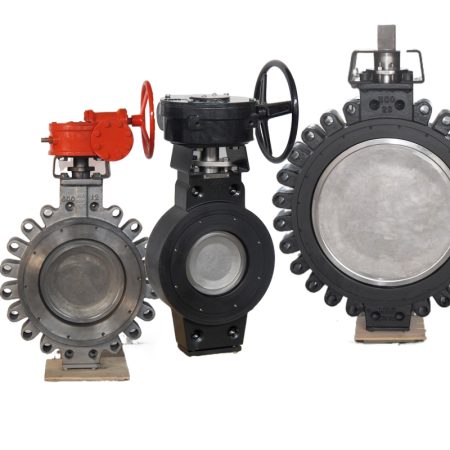
Selecting the right valve for industrial processes can be a complex and challenging task, given the numerous variables and factors that must be considered. Consulting with professionals or manufacturers can provide valuable insights into valve features, materials, performance characteristics, and maintenance procedures, helping operators select appropriate valves that meet their application’s specific requirements. Working with qualified engineers or technicians can also provide additional expertise in determining the appropriate valve size, type, and installation method to ensure safe and efficient operation in industrial processes. By seeking professional assistance and consulting with manufacturers’ specifications and guidelines, operators can make informed decisions that minimize safety hazards, potential equipment damage, and maintenance costs. Encouraging readers to consult with professionals or manufacturers for assistance in selecting the right valve for their application is crucial in ensuring safe and reliable operation and achieving optimal performance in industrial processes.


